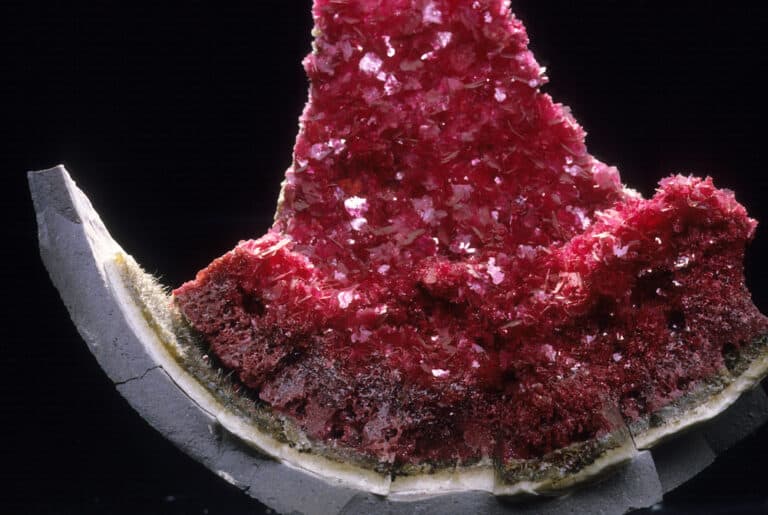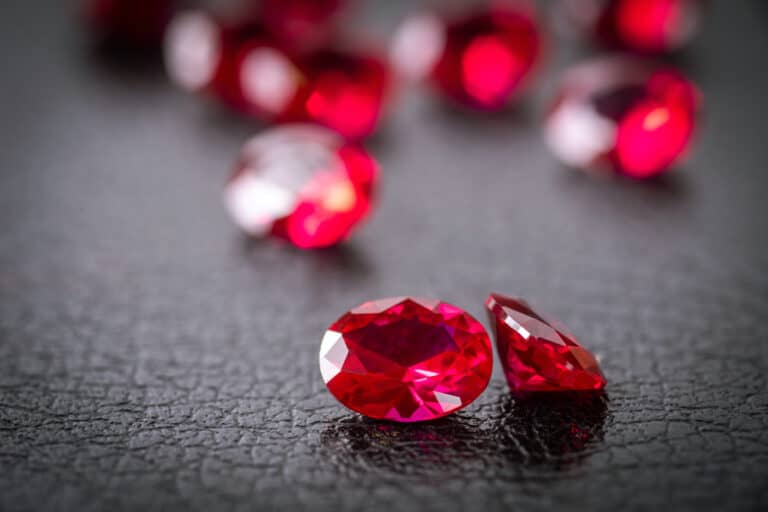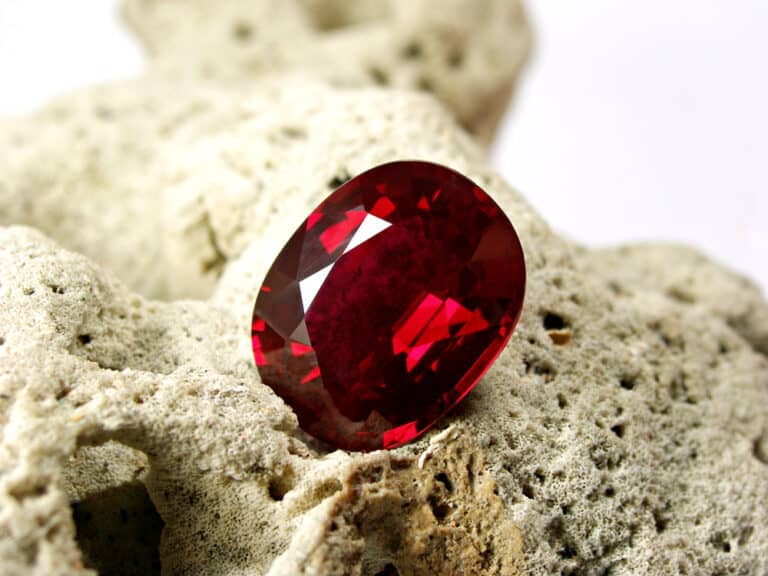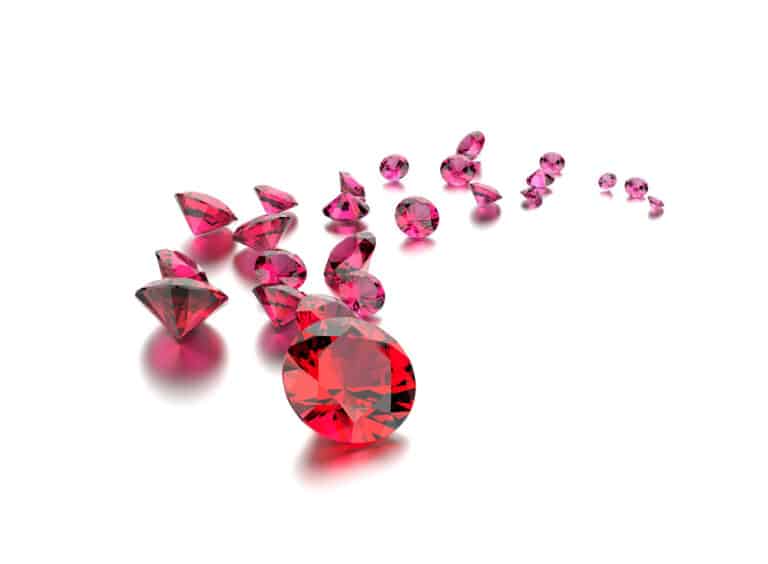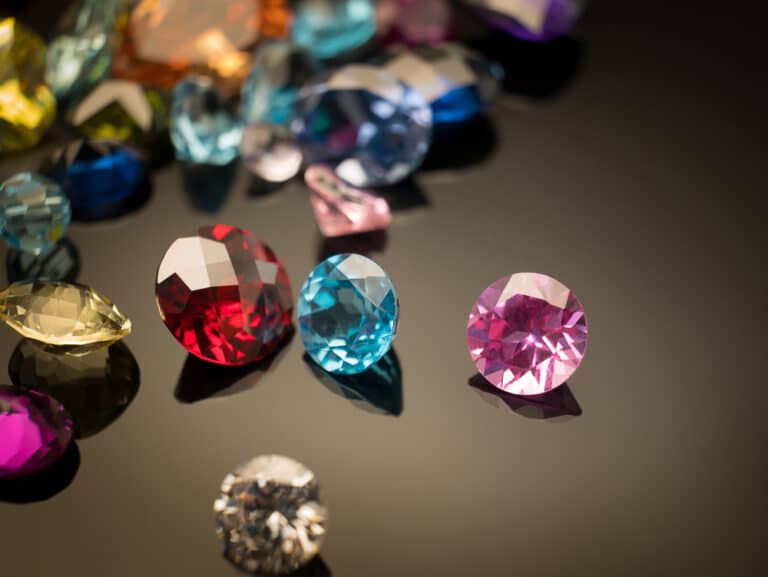Rubies, a gem within the top tier of precious stones, and red beryl, a stone scarcer than diamonds and more valuable than gold, are often mistaken for one another. However, while many think these gemstones are one and the same, they are very different.
Rubies and red beryl display a similar raspberry-red color. However, rubies are composed of corundum and are harder, more resistant stones. In comparison, red beryl gemstones are formed of beryl. Red beryl is also scarcer and more valuable than rubies.
Here’s the real difference between ruby and red beryl gemstones.
Ruby vs. Red Beryl
Although similar in color, ruby and red beryl differ vastly in terms of composition, clarity, cut, carat weight, value, scarcity, location, and uses. Here are the primary differences between ruby and red beryl gemstones.
| Ruby | Red Beryl | |
| Composition | Corundum minerals | Beryl minerals |
| Color | Red (various hues, tones, and saturations) | Red (various hues, tones, and saturations) |
| Clarity | Type II – moderate inclusions | Type III – highly visible inclusions |
| Cut | Flat tabular hexagonal or elongated structures | Elongated hexagonal crystalline structures |
| Carat Weight | Up to a few carats large | Rarely reaching a full carat |
| Value | Large, raw rubies are precious | `Highly valuable |
| Rarity | Somewhat rare | Extremely rare |
| Mining Location | Limited to Utah and New Mexico | Numerous mining pockets worldwide |
| Uses | Jewelry | Collection and custom-made jewelry (poor wearability) |
Ruby vs. Red Beryl: Composition
The first significant difference between rubies and red beryl is their base composition.
The two gems belong to entirely different crystal systems – rubies are part of the trigonal system, whereas red beryl belongs to the hexagonal system. As a result, rubies and red beryl grow in different shapes.
Rubies are composed of corundom mineral species, like sapphires. Like emeralds, red beryl (beryllium) is composed of beryl (beryllium) mineral species.
Beryl is a much weaker mineral than corundum. As a result, rubies are harder, more resistant stones, scoring 9 on the Mohs scale. However, red beryl only rates between 7.5 and 8, making it more susceptible to damage, inclusions, and scratches.
Ruby vs. Red Beryl: 4Cs
Like diamonds, rubies and red beryl are evaluated using the 4Cs to consult the fundamental differences:
- Color
- Clarity
- Cut
- Carat Weight
Ruby vs. Red Beryl: Clarity
Gemstones fall under one of three categories based on their inclusions.
- Type I (eye-clean): No inclusions are visible without magnification like aquamarines
- Type II (moderately included): Inclusions visible without magnification
- Type III (highly included): Inclusions are highly visible without magnification
Rubies are generally considered Type II gemstones, featuring moderate inclusions. However, red beryl is hardly ever eye-clean and mainly falls under Type III gemstones with plenty of inclusions like their emerald mineral cousin.
Rubies vs. Red Beryl: Color
Rubies and red beryl have one factor in common – their color. Gemologists assess the color by describing the hue, tone, and saturation.
- Hue: The color impression noticed immediately (red, purple, orange)
- Tone: The degree of lightness or darkness (light, medium, dark)
- Saturation: The hue’s degree of purity (vivid or dull)
Rubies are available in shades of orange, red, purple, and in-between hues. However, a perfect ruby color is vivid, medium-dark, and absolute red in transparent faceted stones. As the hue leans towards orange or purple, the ruby loses value.
The most sought-after ruby color is “blood red” or “Pigeon Red.”
Red beryl gems display infinite red hues in various tones and saturations. Its color is mostly described as raspberry-pink or gooseberry red; however, you can also get cerise, crimson, scarlet, vermillion, and purplish fuchsia hues.
Red beryl gems with vivid color and rich saturation are of the highest value. However, red beryl is infinitely scarcer than rubies, which is why most red beryl gems are prized at a high value.
Rubies vs. Red Beryl: Cut
Rubies and red beryl need to be cut differently due to their different requirements. The crystalline structure dictates the suitability for specific cutting.
Rubies are extremely hard and lack cleavage – the direction they typically break. Red beryl lacks distinct cleavage but has many inclusions and fractures, making it softer and more brittle than a ruby.
Rubies are naturally a flat tabular hexagonal or elongated shape. They are typically cut into ovals, cushions, rectangles, and squares.
Red beryl is challenging to cut due to its elongated hexagonal crystalline structures and brittle nature. As a result, red beryl mainly receives the titular emerald cuts. However, occasional ovals and cushions are made thanks to modern cutting equipment.
Rubies vs. Red Beryl: Carat Weight
While rubies are typically small, they can grow up to a few carats large. However, red beryl generally only grows to a quarter to a fifth of a carat, rarely reaching one carat.

Ruby vs. Red Beryl: Mining Locations
Rubies and red beryl have vastly different formation conditions.
Rubies are found in numerous mining pockets worldwide. The finest rubies are sources from Burma (Myanmar). However, many rubies come from Afghanistan, Pakistan, India, Sri Lanka, Thailand, Kenya, Vietnam, Australia, Russia, and the United States.
Red beryl is presently limited to three locations globally:
- Utah: The Thomas Range
- Utah: The Wah Wah Mountains (specifically Crystal Peak)
- New Mexico: The Black Range
Ruby vs. Red Beryl: Value & Rarity
High-quality and large rubies (larger than one carat) are extremely rare. However, smaller or commercial-quality rubies are more commonly available.
Rubies’ scarcity and high demand keep their value and prices high. As a result, gems over one carat are exceptionally costly.
Red beryls are one of the rarest gemstones. The Utah Geological Survey estimates that one red beryl crystal is unearthed for every 150,000 gem-quality diamonds found.
Red beryl’s scarcity and beauty are also confirmed in their price. Red beryl can sell for between $1,000 and $30,000 (sometimes more) per carat based on color, clarity, and size.
Conclusion
Rubies and red beryl are vastly different gemstones aside from their color. For example, red beryl is infinitely scarcer than rubies.
However, rubies grow larger than a carat more often than red beryl. In addition, their composition makes them more suitable for jewelry.


